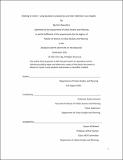| dc.contributor.advisor | Sevstuk, Professor Andres | |
| dc.contributor.author | Klo’e, Ng Yim Chew | |
| dc.date.accessioned | 2022-02-07T15:28:29Z | |
| dc.date.available | 2022-02-07T15:28:29Z | |
| dc.date.issued | 2021-09 | |
| dc.date.submitted | 2021-12-06T19:35:22.294Z | |
| dc.identifier.uri | https://hdl.handle.net/1721.1/140174 | |
| dc.description.abstract | Los Angeles passed one of the largest sales taxes in the country in 2016, which will give the county unprecedented financing in improving public transportation. Public transit ridership has been declining despite hefty investments, and it is important to understand why transit has not picked up. Studying current pedestrian-induced ridership is crucial as walkability is key in affecting ridership. Many prior studies assume linear relationships with established variables or explore transformed variables which have constrained assumptions. Machine learning models have the potential to discover nonlinear relationships such as step function and curvilinear relationships, which will help planners and policy makers make effective development decisions. | |
| dc.publisher | Massachusetts Institute of Technology | |
| dc.rights | In Copyright - Educational Use Permitted | |
| dc.rights | Copyright retained by author(s) | |
| dc.rights.uri | https://rightsstatements.org/page/InC-EDU/1.0/ | |
| dc.title | Walking to transit – using big data to analyze bus and train ridership in Los Angeles | |
| dc.type | Thesis | |
| dc.description.degree | S.M. | |
| dc.contributor.department | Massachusetts Institute of Technology. Department of Urban Studies and Planning | |
| dc.identifier.orcid | 0000-0003-4033-9909 | |
| mit.thesis.degree | Master | |
| thesis.degree.name | Master of Science in Urban Studies and Planning | |
